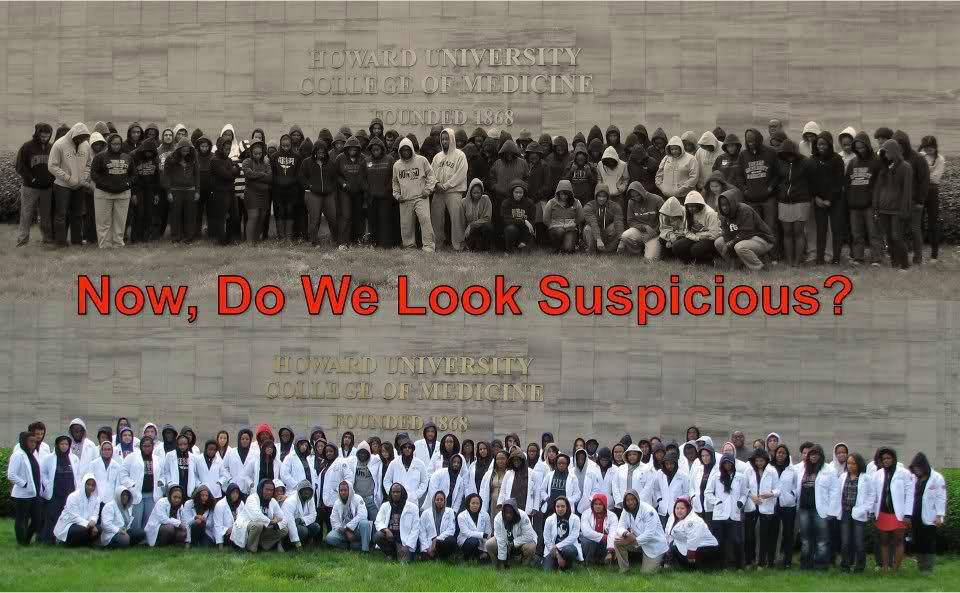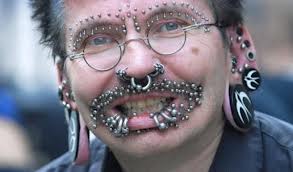It all started with a friend of mine posting this picture on her Facebook page.
The picture is from an effort to bring attention to an ongoing profiling campaign:
This image is going around today, as students mobilize through the “Am I Suspicious?” campaign, “seek[ing] not only to raise awareness of the injustices that go on today and have happened in the past, but to prevent such occurrences for future generations.”
I was immediately struck that something wasn’t fitting. The question, the picture and the comparison didn’t fit. I tried calling shenanigans on her post but Facebook is a poor medium to handle back and forths. So I’ll try this blog post.
So, first, I think that the question isn’t being phrased correctly. I get the point. Just because someone is wearing a hoodie doesn’t mean that they are a criminal or a nar do well. And by using dental students, widely assumed to intelligent and law abiding, as examples of people who don hoodies that aren’t criminals, the point is attempted to be brought into stark focus.
But they aren’t asking the fair question. If they wanna make a comparison of 50-70 dental students in and out of hoodies, the question, to be honest, would be
“Do you think that all people in hoodies are criminals?”
But they didn’t ask that question. They asked the logically incompatible question:
“Now, do we look suspicious?”
And if you object to my complaint regarding the proper question, I can amend it. I’ll change it to this:
“Now, do we look more suspicious than we other wise would have if we were in our medical jackets?”
And the answer to THAT question is, without a doubt, “yes.”
And I think that everyone in America would agree with that answer. Because by answering that question in the affirmative makes no claim that all people wearing hoodies are up to no good. Nor does it say that people who are up to no good wear hoodies. If asked in an intellectually honest vein, the answer is yes.
I’ve been thinking about this for several days now. And the best way to explain what I’m talking about is to use a term that I’ll call:
Default Societal Trust
This is the trust extended between two people when meeting in society for the first time in day to day life. That is, if I’m in a store and see someone in the aisle, or I’m walking down the street and meet someone on the sidewalk. When I’m in a restroom at the burger joint and another guy walks in. Just a random general anonymous encounter.
I suggest that when people signal us in a “mainstream” manner – we extend them a general level of trust. Whatever that level is doesn’t really matter. However, I would think that it rates as feeling comfortable with asking the person for the time, or a bus schedule. Not asking them to borrow money or the newspaper they are reading. In days gone by, someone that you could bum a smoke from but not someone that you would trust to watch a laptop while you stepped away.
General trust.
And when people present out of the mainstream in some way, that trust can be lowered to some level less than it other wise might have been.
Consider this guy for example:
Now, consider the same guy but presenting like this:
Less societal default trust. The kid in a full body tattoo pattern is signaling society in such a way that is not mainstream. And the level of default trust is diminished. It is less than it otherwise might have been.
And we have no idea if this kid is a premed student, a gifted pianist or a criminal.
Now this guy:
It might be a add-on argument to the tattooed kid above, but in general, “biker dudes” tend to be seen with diminished levels of societal trust. To be sure, there are many lawyers, doctors and other highly respected professionals that throw on the leather every weekend and again in the first week of August that have not one single criminal intent in their bodies.
Meet one on the street for the first time? Less societal trust than would other wise be extended.
How about this individual:
Or this guy:
In both cases, the individual in question could be the coolest, most intelligent and compassionate guy you would ever wanna meet. But when first met, in the restroom, or in the bar, on the street or in the elevator, the level of suspicion will be elevated and the level of societal trust will be less than it otherwise would have been had the person signaled or presented in a more mainstream manner.
I don’t think that this is surprising or even controversial. In fact, I suspect that societies signal mainstream as a means of survival and cohesion.
All of which is a very long way of saying that when people wear a hoodie, in certain and specific contexts, they are presenting or signalling in a more suspicious manner than they otherwise might have.







Pingback: Social “Presenting” | Tarheel Red